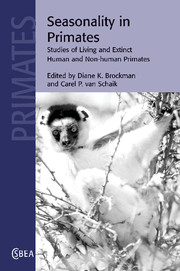Book contents
- Frontmatter
- Contents
- List of contributors
- Preface
- Part I Introduction
- Part II Seasonal habitats
- Part III Seasonality and behavioral ecology
- 3 The influence of seasonality on primate diet and ranging
- 4 Seasonality in predation risk: varying activity periods in lemurs and other primates
- 5 Physiological adaptations to seasonality in nocturnal primates
- 6 Seasonality and long-term change in a savanna environment
- 7 Day length seasonality and the thermal environment
- 8 Seasonality in hunting by non-human primates
- 9 Human hunting seasonality
- Part IV Seasonality, reproduction, and social organization
- Part V Seasonality and community ecology
- Part VI Seasonality and human evolution
- Index
- References
3 - The influence of seasonality on primate diet and ranging
Published online by Cambridge University Press: 10 August 2009
- Frontmatter
- Contents
- List of contributors
- Preface
- Part I Introduction
- Part II Seasonal habitats
- Part III Seasonality and behavioral ecology
- 3 The influence of seasonality on primate diet and ranging
- 4 Seasonality in predation risk: varying activity periods in lemurs and other primates
- 5 Physiological adaptations to seasonality in nocturnal primates
- 6 Seasonality and long-term change in a savanna environment
- 7 Day length seasonality and the thermal environment
- 8 Seasonality in hunting by non-human primates
- 9 Human hunting seasonality
- Part IV Seasonality, reproduction, and social organization
- Part V Seasonality and community ecology
- Part VI Seasonality and human evolution
- Index
- References
Summary
Introduction
To sustain animal populations, an adequate supply of consumable resources is essential. Effects of insufficient resources are well documented in primate populations in the form of reduced rates of fecundity, growth, and survival (Altmann et al. 1977; Hamilton 1985; Gould et al. 1999). Weight loss (Goldizen et al. 1988) and mortality peak during periods of low food availability on an annual (Milton 1980) or interannual basis (Foster 1982; Wright et al. 1999). Food availability relative to consumer requirements has been estimated as seasonally deficient in some (Smythe et al. 1982; Terborgh 1986; Janson & Emmons 1990) but not all (Coehlo et al. 1976) cases. Identifying food-limiting periods generally involves comparisons between estimates of food supply and animal requirements, which in turn require estimates of population density, biomass, energy intake, and metabolic rate. Field techniques measuring doubly labeled water (Nagy & Milton 1979; Williams et al. 1997) and products of fat metabolism in urine samples (Knott 1998) (see also Chapter 12) are highly informative in determining whether consumers are operating at a negative energy balance. The great majority of studies, however, rely on phenological monitoring to suggest periods of food scarcity for vertebrate consumers.
Phenological monitoring has revealed spatial and temporal variation in the availability of ripe fruits and young leaves in practically all forests studied (see reviews by van Schaik et al. [1993], [Fenner 1998], [Jordano [2000], and van Schaik & Pfannes [Chapter 2 of this book]).
- Type
- Chapter
- Information
- Seasonality in PrimatesStudies of Living and Extinct Human and Non-Human Primates, pp. 57 - 104Publisher: Cambridge University PressPrint publication year: 2005
References
Accessibility information
- 133
- Cited by

